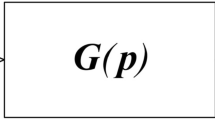Abstract
Research in optimum structural design has shown that mathematical programming techniques can be employed efficiently only in conjunction with explicit approximate constraints. In the course of time a well-established approximation for homogeneous functions (scalable structures) has emerged based on the linear Taylor expansion of the displacement functions in the compliance design space (Reciprocal approximation). It has been shown that the quality of this approximation is based on the property that homogeneity of the constraints is maintained and consequently the approximation is exact along the scaling line.
The present paper presents a new family of approximations of homogenous functions which have the same properties as the Reciprocal approximation and which produce more accurate models in most of the tested cases. The approximations are obtained by mapping the direct linear Taylor expansion of the constraints unto a space spanned by intervening variables (original design variables to a powerm). Taking the envelope of these constraints along the scaling line yields a new family of approximations governed by the parameterm. It is shown that the Reciprocal approximation is a particular member of this family of approximations (m = −1).
The new technique is illustrated with classical examples of truss optimization. An optimal plate design is also reported. A parametric study of the results for various values of the exponentm is presented. It is shown that for special values of the exponentm the new approximations usually yield better models than those based on the Reciprocal approximation.
Similar content being viewed by others
References
Armand, J.L.; Lodier, B. 1978: Optimal design of bending elements.J. Num. Meth. Eng. 13, 373–384
Fleury, C. 1979: A unified approach to structural weight minimization.J. Comp. Meth. Appl. Mech. Eng. 20, 17–38
Fleury, C.; Sander, G. 1981: Dual methods for optimizing finite element flexural systems.Report SA-87, Aerospace Laboratory Liège, Belgium
Fuchs, M.B. 1980: Linearized homogeneous constraints in structural design.Int. J. Mech. Sci. 22, 33–40
Fuchs, M.B. 1982: Explicit optimum design.Int. J. Solids and Struct. 18, 13–22
Fuchs, M.B. 1983: Explicit optimum design technique for linear elastic trusses.J. Eng. Opt. 6, 213–218
Haj Ali, R.M. 1989:Generalized approximations of homogeneous constraints in optimal structural design. M.Sc. Thesis, Dept. Solid Mechanics, Materials and Structures, Faculty of Engineering, Tel-Aviv University (in Hebrew)
Haug, E.J.; Arora, J.S. 1979:Applied optimal design. Chichester: John Wiley & Sons
Imai, K. 1977: Configuration optmization of trusses by the multiplier method.UCLA-ENG-7842, School of Engineering, University of California, Los Angeles
Kirsch, U. 1984: Approximate behaviour models for optimum structural design. In: Attrek, E.et al. (eds.)New directions in optimum structural design, Chapter 17, pp. 365–384. Chichester: John Wiley & Sons
Levy, R.; Ovdia, E.L. 1987: Recent developments in structural optimization.J. Struct. Eng. 113, 1939–1962
Prasad, B 1983: Explicit constraint approximation forms in structural optimization. Part I: analysis and projections.J. Comp. Meth. Appl. Mech. Eng. 40, 1–26
Prasad, B.; Haftka, R.T. 1979: Optimal structural design with plate finite elements.J. Struct. Div. ASCE 105, 2367–2382
Schmit, L.A. 1960: Structural design by systematic synthesis.Proc. Second Conf. Electronic Computation, ASCE (held in Pittsburgh, Pa.), pp. 105–132
Schmit, L.A. 1981: Structural synthesis — its genesis and development.AIAA J. 16, 1249–1262
Schmit, L.A.; Farshi, B. 1974: Some approximation concepts for structural synthesis.AIAA J. 12, 692–699
Starnes, J.H.; Haftka, R.T. 1979: Preliminary design of composite wings for buckling, stress and displacement constraints.J. Aircraft 16, 564–570
Vanderplaats, G.N. 1984: ADS — A Fortran program for automated design synthesis.NASA-CR 172460
Venkayya, V.B. 1971: Design of optimum structures.J. Comp. Struct. 1, 265–309
Author information
Authors and Affiliations
Rights and permissions
About this article
Cite this article
Fuchs, M.B., Haj Ali, R.M. A family of homogeneous analysis models for the design of scalable structures. Structural Optimization 2, 143–152 (1990). https://doi.org/10.1007/BF01836563
Received:
Issue Date:
DOI: https://doi.org/10.1007/BF01836563




